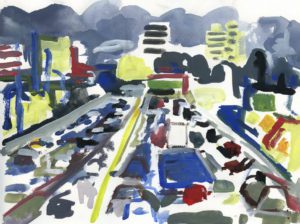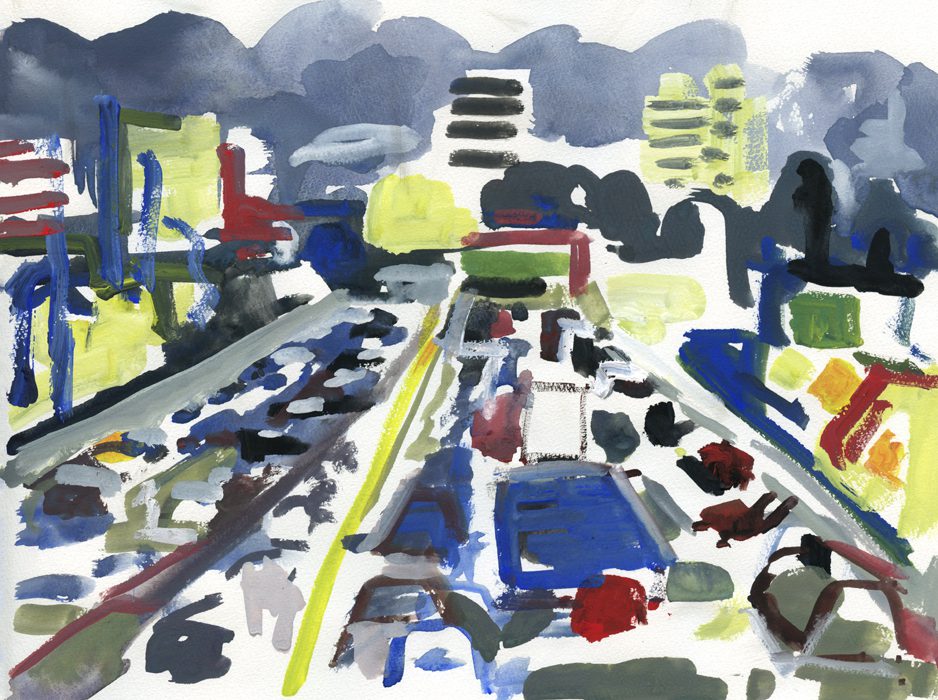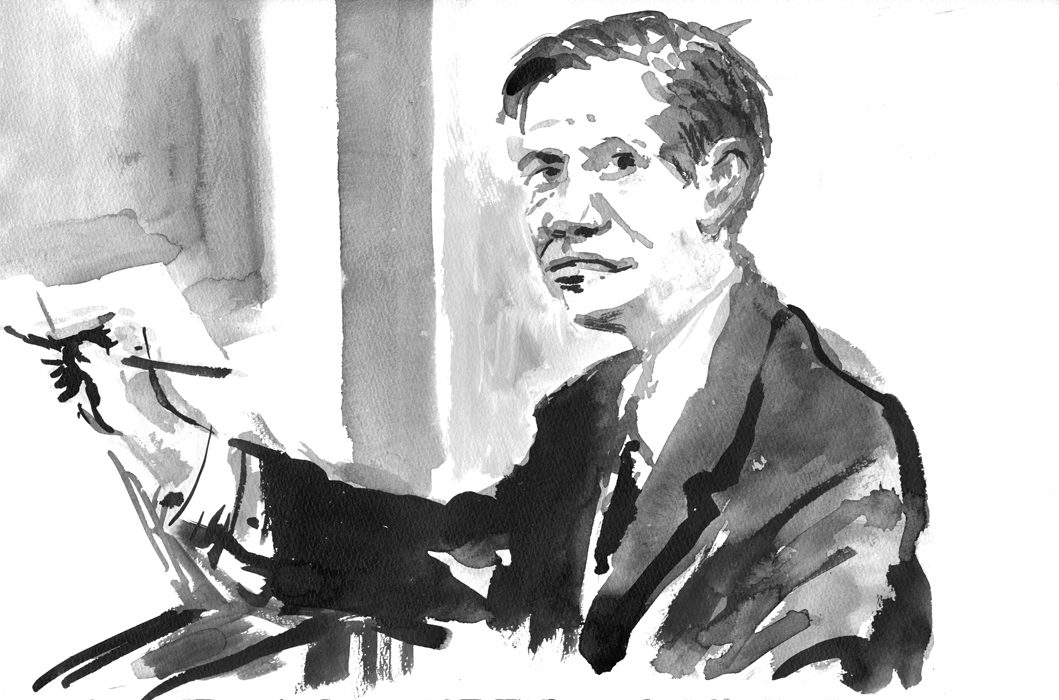
I will build a house overlooking the 101 using all of the things lost on the highway. I will listen to the traffic reports—to the so-called Swerve Alerts—to find my furnishings. They will tell me exactly what has fallen from the roofs of cars, from the backs of pickup trucks, fallen away from movers, from gardeners, from the overcast sky perhaps, and where it is, and in what lane even. There, in the fourth lane, I will find my carpet, and my sofa and chair. My new lawnmower and garden hose are in the HOV lane, my glass for windows and pipes for plumbing are scattered everywhere, and as many mattresses as I need have drifted over to the breakdown lanes. A fire extinguisher for emergencies. A bare Christmas tree, waiting for decoration, will arrive in December. And a suitcase, right smack dab in the middle of the freeway and most likely filled with clothes, for starting my new life in Los Angeles.
My new life in Los Angeles revolves around scraps of things. I save things. I save this list for example, of the hazards of the road, the detritus of the freeway, because this is what I do—I am an archivist and I keep things from being forgotten. I am the one who keeps track of other peoples’ stories, their birth and death dates, the chronologies of their lives. I organize the items they’ve left behind, even the bits they never meant to save or wanted seen. I seal the evidence, close the vault; I appear to stop time.
I came to Los Angeles passing black, curving skid marks everywhere on the highway on the way here. I arrived in this place, this destination—Los Angeles—as so many others have done. The hills were brown and dusty; the freeway droned. I arrived here, not young anymore, and took a job as an archivist where I open boxes, sort and arrange, investigate and identify, and spend my days with others who are gone, but once arrived here, too. Like them, I would have to learn how to measure the passage of time in this place—not by calendars, almanacs, or logbooks, but in other ways; I would learn to notice, for instance, how over the years all the trees in the neighborhood seem to be coming down, some slowly, some all at once. I record the rustle of dried-up leaves and the cracking of dead limbs, the steady toll when they hit the sidewalks as the tree gradually disappears. I note the silence of the empty space where the tree once was, an absence that will someday be forgotten.
Does anyone remember the composer George Antheil, who came to Los Angeles in 1936? Few people do. George Antheil arrived in Los Angeles as I did, after driving cross-country from New York City. Antheil was known in his day as “the bad boy of music.” In Paris, in the 1920s, he was a young, American composer on the rise. He’d been born with the new century, and believed in doing away with the past. He lived above the Shakespeare & Co. bookstore and crossed paths with everyone who was someone in Paris then: Ezra Pound, James Joyce, Ernest Hemingway, Picasso, Erik Satie. Ezra Pound wrote a book about his music. In 1924, Antheil completed his best-known composition, the Ballet Mécanique, meant to accompany a Fernand Léger silent movie of the same name. Ballet Mécanique was the noise of modern life, the cacophony of the new century; the-future-is-now and all that. The noise was all new, then. Like everything in Paris at that time, it seems, its public debut caused a riot—or at least there was booing and shouting and shrieking, according to those present. People fainted, or so it was said. Ezra Pound called the audience imbéciles (en français). Music was noise, and noise was music, and George Antheil was on his way.
I met George Antheil in the archives; I worked on his papers—lucky me, who has always had a thing for the bad boys of music. Young George Antheil with his slicked-back dark hair and his crooked nose. The papers that I worked on were from his later years, his Los Angeles years when he came to write music for movies after his grand failure. I sifted through the scores he wrote for now-forgotten films: The Buccaneer, Knock on Any Door, Once in a Blue Moon, and Dementia, the experimental black-and-white film from 1955 which begins with a woman sleeping, her hands curling, and everything that follows is maybe a dream. Dementia has no words, only music. I see the nameless woman running in the dark. She is caught in a spotlight, frozen in a white circle of light.
George Antheil’s Los Angeles compositions contained secrets, it turned out. He had left his scores in disarray. Love letters from his mistress were hidden among the cues and themes, the notes and staff lines: urgent missives and telegrams, and a heart cut out of silver paper.
When George Antheil arrived in Los Angeles, he was on the way down, though maybe he was not aware of that yet. He was still in his thirties and had no way of knowing his life was more than halfway over. His career was on the decline but he was in a new place, the West, and must have had high hopes for some sort of fresh start. Los Angeles was unknown and there were things to learn about the place, things to get used to. Did his friends advise him on the passage of time, as mine did? How you never know what time of year it is, as there are no fixed seasons, so you have to look for different things? The other transplants would surely have warned him of the years that fly by unnoticed. They would tell him to look for the slants of light, and when and where they hit; to study the shadows to mark time. To note exactly when the sun falls behind the brown hills, and to understand that, in this way, your life passes.
(I learned early on that wind is its own form of weather here. It has its own seasons, and the things it scatters about have seasons, too. First there were the pine needles. Then the little orange spores that gathered in clumps in the corner of the patio and created a fine powder when crunched underfoot. Lately the tall eucalyptus trees nearby have been shedding, and pieces of bark float down from above. And every time the wind blows, it takes the palm fronds with it, which lie in the roads looking like dead animals or discarded clothes.)
George Antheil wasn’t the only one to arrive in Los Angeles on the decline. There were other composers, and writers, too, who sold out to Hollywood. There were exiled European intellectuals who saw the city as a big step down. Not to mention the nineteenth-century consumptives, the sick, who believed the promotional literature professing that in this city they would be healthy again, that they would survive. As historian Kevin Starr writes about the time: “The promise, of course, outran the reality. Some found restoration, but many more coughed away what little life remained, alone and lonely in a faraway land, mocked by the sunshine they thought would save them… In Los Angeles during these years, death seemed everywhere, and a mood of death, strange and sinister, like flowers rotting from too much sunshine, remained with the city.”1
George Antheil’s grand failure was this: one poorly executed performance of the Ballet Mécanique at Carnegie Hall in New York in 1927. It was the piece’s US premiere and it was hyped as scandalous: come see the riot! Antheil later said he only took the gig for money. It was the promoter’s idea to hype the thing. The added pianos that mucked up the sound were due to pressure from the piano sponsor. Ten pianos and six xylophones. Antheil was recovering from pneumonia. The visible propeller was such a bad idea! The music was to mimic propeller sounds, not accompany the actual thing. The actual thing threatened to blow peoples’ hats off. The siren went off too late and wouldn’t stop. The story that everyone remembered was of an audience member holding up a cane with a white handkerchief tied to it, in a form of surrender. No one rioted; they just walked out as the siren blared. Antheil’s career was never the same after that night.
The original score of the Ballet Mécanique uses silence, drawn-out measures where the noise disappears. Antheil expounded on his music in a 1927 untitled manuscript, writing that time is the “principal subject” of his work, and that, in the ballet, silence is time acting as music. In the end, George Antheil had a heart attack and died quite suddenly on a cold day at the age of fifty-eight while revisiting the vertical city that had rejected him. His mistress had been sending him urgent telegrams and silver hearts, and his scores were in disarray.
Meanwhile, I organize and arrange and put things in folders, and open boxes of dead composers’ papers that are filled with receipts from Sav-On drugstores and liquor stores, with wedding invitations and utility bills, and I am momentarily overwhelmed by the futility of everything. I drive over the brown hills and down the freeways. I see a terrified deer on the 405 early one morning with cars in slow formation behind it. The deer was heading north, fleeing the city. I wait for rain to wash away the skid marks and make the hills green again.
There was a brief earthquake one night around four in the morning, soon after I arrived in town. I happened to be up, awake with insomnia, and was sitting on the red couch in the middle of the living room. The earthquake started in a dark corner, then rolled across the floor behind me, heading for the door. It seemed a ghost was running past, skirting the shadowy couch where I sat. The doorknob rattled as if someone was trying to get outside. I might have thought it was George Antheil hurrying through, looking for his mistress. Looking for his silver heart and to see what the wind was blowing about; trying to find the slant of light in the darkness, and how the time ran out on him. The earthquake was music, and the rattling of the door was music, too. Then silence—a real four-in-the-morning silence. It was so quiet, in fact, that I could hear George Antheil whispering in the darkness. Silence is time acting as music, he said. Listen up, Los Angeles.
***
Rumpus original art by Dmitry Samarov.
***
1. Kevin Starr, Inventing the Dream: California through the Progressive Era (Oxford University Press, 1985) 55.↩







